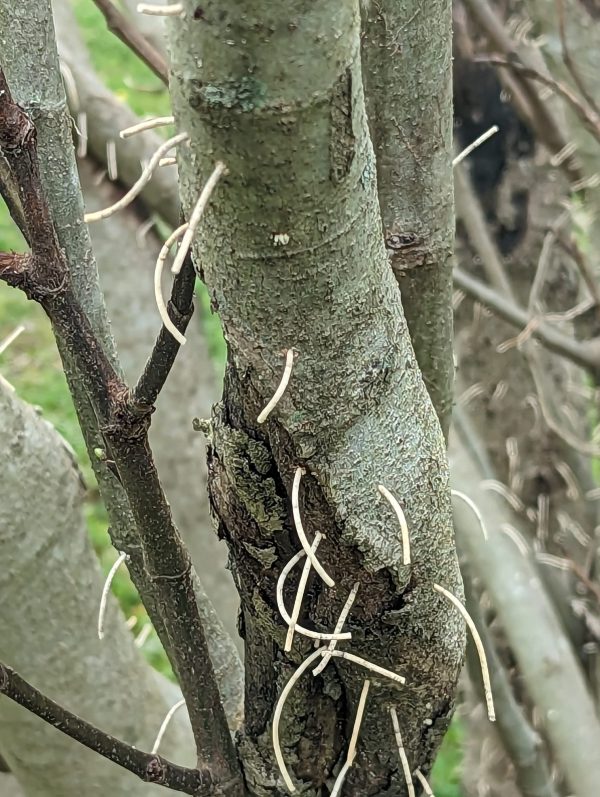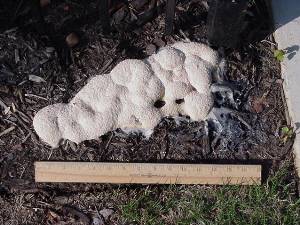Compost Tea – Does It Work
Linda Chalker-Scott is a scientist at Washington State University who researches common garden claims and comments on their usefulness. Her thoughts on compost tea are printed below:
WSU Master Gardeners are often asked about compost tea (and other products) but may not have ready access to objective information. This column is dedicated to those hard-working volunteers who want the current best science on products and practices so that they can continue to learn and inform others.
What is compost tea?
The historical manufacture and use of compost leachates and extracts is a straightforward, centuries-old practice. Plant and animal wastes were placed into a permeable bag and held in a bucket of water until the water turned black. (It’s easy to see how the analogy to tea emerged.) Both indoor and outdoor plants could be watered with this solution containing nutrients and microbes. More recently, the process has been adapted for the compost tea market. One can buy a compost tea brewer, or purchase ready-made teas at nursery and garden centers.
The original method of compost extraction is passive – it does not require an energy input. This method produces non-aerated compost tea (NCT) whose principal components are thought to be anaerobic microbes and nutrients. The concept behind the passive method calls for use of stable composts without other food-source additives, such as sugar, to minimize oxygen demand and thus prevent anaerobic conditions from developing. Traditionally, this European method of compost tea production incorporates occasional stirring (perhaps daily) of the extracts. (Though detractors often allege that NCTs are anaerobic, in fact properly formulated NCTs are hypoxic, or low oxygen – not anaerobic.) NCTs have a long tradition of use as a liquid fertilizer and in the 1980’s were the subject of disease-suppression research in Europe.
In contrast, compost tea brewers require an energy input in the form of an aerator. This constantly oxygenated mixture forms aerated compost tea (ACT), which contains aerobic microbes and nutrients. ACT will become NCT if aeration stops; likewise, NCT will be converted into ACT if aerated.
Sales literature for ACTs and compost tea brewers states that ACT will produce “lush foliage,” “beautiful blooms,” “delicious fruits and vegetables,” and “thick green turf” while keeping “garden plants, turf, and crops free of disease.” This information is presented as factual, and when combined with the imagery of nurturing an ailing garden with a cup of tea, proves irresistible to many people.
Does compost tea work?
This is a complicated question that can only be answered by reviewing the scientific literature on NCTs and ACTs. Scientific literature is the body of information that has been peer-reviewed and is often geared to an academic audience. Extension publications are also in this category since they are peer-reviewed but target a more general audience. When an article appears in a peer-reviewed journal or book, it means the methods, results, and conclusions were found to be scientifically valid by objective outside experts.
Other information sources include gray and popular literature, neither of which are peer-reviewed and primarily focus on professional and general audiences,respectively. (This article, for instance, would fall into this category.) These resources can be valuable as well but the objectivity and credibility of the information need to be assessed. For the purposes of this article, only those results reported in the scientific literature are reviewed.
Scientific research on compost tea has focused most commonly on foliar disease control. As of this writing, there have been 34 papers published on the efficacy of NCT on disease control. Often, good results are found under laboratory conditions though field results are more variable. There appears to be a trend for NCTs to reduce the incidence, but not the severity, of foliar diseases.
In comparison, there have been 7 papers published on ACTs and disease control. Again, there was some success with fungal control in Petri dishes in the lab (1 paper), but less consistency in greenhouse conditions (3 papers). Two field-based studies report that not only was ACT ineffective in preventing foliar pathogens, it exacerbated disease organisms in both apples and potatoes. Clearly, the science is not strong for ACT use on crop plants, much less on lawns, shrubs, and trees.
Why isn’t there more scientific research on compost tea?
While a number of universities are investigating the effect of ACTs on disease control, very few studies have been published. To understand why, let’s quickly review what is needed for a scientific experiment:
• Controls: For every plant that is treated with compost tea, another needs to be treated with water.
• Replicates: To obtain statistically valid data, each treatment needs to be replicated. In controlled environments such as laboratories, there can be as few as three replicates. For more variable environments, such as greenhouses, there may be ten replicates. In a field situation – the real world – 20 replicates is not uncommon.
• Repetition: To verify the results from the first trial, the experiment should be repeated. In general, three repetitions are considered the minimum.
Compost teas are highly variable in their microbial and nutrient content from batch to batch. This translates to high variation within data sets and often leads to inconclusive results. Unfortunately, these results are often not published even though they are just as important as positive outcomes. In other words, if a particular treatment doesn’t work well under controlled experimental conditions, it’s unlikely to work consistently anywhere else.
In addition to the published results discussed earlier, there are university reports of ongoing research that I’ve briefly summarized at Compost Tea Research
Can WSU Master Gardeners recommend compost tea use?
The short answer is no. Because WSU Master Gardeners are volunteer educators who rely on science-based information, they cannot recommend a practice or product that lacks a legitimate scientific basis. Furthermore, it is illegal to sell unregistered substances for use as pesticides. At this point there are no compost tea products registered as pesticides with the US Environmental Protection Agency (USEPA).
Neither WSU MG volunteers nor websites should encourage the use of compost tea as a pesticide.
If compost tea doesn’t do anything, then how can it hurt to apply it?
“While the scientific evidence is certainly lacking for ACT activity in disease control, there is a serious, documented concern with these types of compost teas,” says Dr. William R. Schneider, a research scientist in the Biopesticides & Pollution Prevention Division (Office of Pesticide Programs) of the USEPA. He continues “it is very difficult to do a microbial pesticide risk assessment on a mixture of unidentified microorganisms that could easily contain human and nontarget organism pathogens.”
Indeed, this risk is significant in ACTs that have been “enhanced” with molasses, kelp, and other high-nutrient additives. Such ACTs have been documented through scientific research to contain E. coli and Salmonella populations, both of which are human pathogens. The recent deaths due to E. coli-contaminated spinach illustrates how dangerous compost tea applications can be, particularly on food crops.
What are alternatives to compost tea?
Rather than spending time and money leaching materials out of compost, why not use the intact compost as part of an organic mulch layer? There is substantial evidence in the scientific literature that organic mulch benefits gardens and landscape by:
• Improving soil moisture
• Reducing soil erosion and compaction
• Maintaining optimal soil temperatures
• Increasing soil nutrition
• Improving plant establishment and growth
• Reducing weeds
• Reducing disease
• Reducing pesticide use
These last two points are particularly germane to our discussion. Organic mulch has been shown to suppress disease biologically, chemically and physically through competition, chemical inhibition, and reduced pathogen dispersal, respectively.
While compost alone may not be sufficient for a landscape mulch, it can be an important component. Furthermore, mulched landscapes are usually more aesthetically appealing and of greater economic and environmental benefit as they require fewer additions of fertilizers and pesticides. Best of all, this management plan is based on objective plant and soil sciences – not wishful thinking.
(A complete bibliography of the scientific and gray literature on compost tea is available by email from the author.)
Dr. Linda Chalker-Scott, PhD
Associate Professor and Extension Urban Horticulturist
WSU Puyallup Research and Extension Center
7612 Pioneer Way E
Puyallup, WA 98371
Phone: (253) 445-4542
Email: lindacs@wsu.edu
URL: http://www.puyallup.wsu.edu/~Linda%20Chalker-Scott














